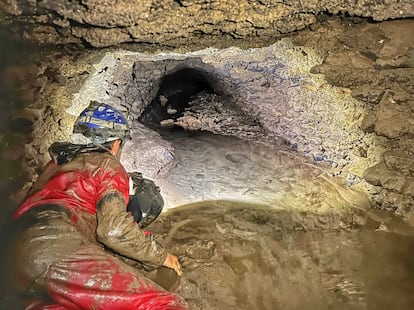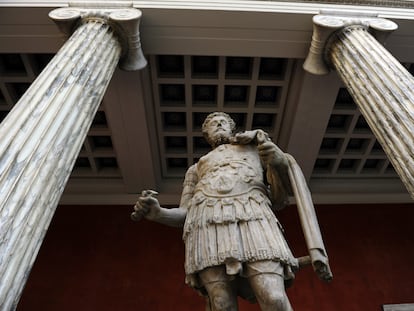Were sausage dogs pitted against lions in the Colosseum?
Excavations have revealed new information about the structure and workings of the Roman amphitheater although questions remain, including what role dachshunds played
From the sandy floor of the Colosseum, everything must have looked impressive – or terrifying. Crowded stands, screaming people. And, just a few feet away, colossal creatures with sharp teeth and claws.
It’s difficult to imagine how the poor dachshunds paraded through the Colosseum of Rome must have felt. But what we do now know, with certainty, is that the little dogs were there. Walking slowly on their short legs, they were forced to be in the presence of lions, leopards and bears.
“We have found the remains of small dogs, with very short extremities. They may have been forced to fight each other or larger predators. Or, perhaps, they were made to walk alongside the bigger creatures to make people laugh,” notes Federica Rinaldi, the scientific director of the recent excavations that took place in the sewers of the best-known amphitheater in the world.
Deep beneath the structure, researchers have detected residues that allow us to understand more about the ancient practices and diets of the Romans during the gladiator era. And, of course, about the sanitation system itself.
It may seem a bit odd that, after two millennia, there are still new discoveries to be made in one of the most studied areas on the planet. “The Colosseum has not yet been fully excavated. Some of the oldest levels still haven’t been found. Due to the complexity and safety precautions around this operation, the sewage system took a long time to access,” notes Rinaldi.
From January to September 2022, a team of archaeologists and speleologists (scientists who study caves) excavated the southern part of the monument. They delved into the archives, hunting for documents from the 19th century that would explain the alterations made in the underground conduits beneath the Colosseum. The researchers literally plunged into the sewers themselves. “We have walked, crawled or crouched through [500 feet] of old sewers,” Rinaldi sighs.

These efforts brought forth a stream of information. Some discoveries speak to the history of the Roman Empire, while others are more related to the day-to-day lives of Roman citizens. It has also been revealed that the construction of the Colosseum – which began in 70 AD – was led by engineers who preferred to restore and reuse pre-existing hydraulic manifolds, even if they were hundreds of years old. They opted to recycle materials, rather than build from scratch.
“Over the centuries, [the engineers] were able to update the functions [of the pipelines] and, despite earthquakes, landslides or urban modifications, maintain the original appearance,” Rinaldi explains.
The team also gained more knowledge about the water collection system, which still proves useful today when draining water from Rome’s streets. However, other details have made headlines in the Italian and international press.
Judging by the remains that appeared during the excavation, it is clear that, during the shows in the amphitheatre, spectators consumed large quantities of grapes, figs, melons, peaches, walnuts, olives and cherries.
“It’s also very likely that the public – who entered in the morning and left at night – cooked meat on improvised braziers,” Rinaldi adds. The discovery of spices such as coriander, anise and fennel reinforces this hypothesis.
Rinaldi also highlights another discovery: woody plants, which confirm the accounts of poets from Ancient Rome, who wrote about the re-creation of forest and jungle settings on the sand of the Colosseum. This provided a more authentic backdrop to the gladiators and exotic animals who were forced to fight.

During the day-long battles, citizens also appear to have brought along their own entertainment and creature comforts: chess boards and combs were extracted from the sewers. There were also coins – even though the games were free for the public, some would throw money into the arena. Or perhaps they simply fell out of people’s pockets during the revelry.
Rinaldi speaks with a contagious passion about the discoveries, which feed the desire to dream about the past. However, she’s also cautious about what the excavations can and cannot confirm.
“Following our study, we cannot state with absolute certainty whether or not naval battles flooded water into the interior of the Colosseum. It was not the objective of our investigation. In any case, it would be necessary to continue excavating in the eastern sector. The hydraulic system has changed over the centuries: it’s uncertain that it can be reconstructed exactly as it originally was.”
There are also no conclusive results regarding whether or not the Colosseum suffered several collapses throughout history. Rinaldi has asked the media for time and prudence, since the research team has only recently reached the archaeological levels they were trying to access. She reminds us that “archeology is a slow science.” The ancient history buff’s fantasy, on the other hand, can run wild and fast. Like a dachshund and a lion.
Sign up for our weekly newsletter to get more English-language news coverage from EL PAÍS USA Edition
Tu suscripción se está usando en otro dispositivo
¿Quieres añadir otro usuario a tu suscripción?
Si continúas leyendo en este dispositivo, no se podrá leer en el otro.
FlechaTu suscripción se está usando en otro dispositivo y solo puedes acceder a EL PAÍS desde un dispositivo a la vez.
Si quieres compartir tu cuenta, cambia tu suscripción a la modalidad Premium, así podrás añadir otro usuario. Cada uno accederá con su propia cuenta de email, lo que os permitirá personalizar vuestra experiencia en EL PAÍS.
¿Tienes una suscripción de empresa? Accede aquí para contratar más cuentas.
En el caso de no saber quién está usando tu cuenta, te recomendamos cambiar tu contraseña aquí.
Si decides continuar compartiendo tu cuenta, este mensaje se mostrará en tu dispositivo y en el de la otra persona que está usando tu cuenta de forma indefinida, afectando a tu experiencia de lectura. Puedes consultar aquí los términos y condiciones de la suscripción digital.
More information
Últimas noticias
Maduro pleads not guilty before the federal court in New York: ‘I am still the president of Venezuela’
A new test can detect Alzheimer’s from a finger prick
UN team enters Sudanese city of El Fasher after paramilitary massacre: ‘It’s like a ghost town’
A recipe for resistance: Indigenous peoples politicize their struggles from the kitchen
Most viewed
- Gilles Lipovetsky: ‘If you want to live better and fall in love, take Prozac, don’t look to philosophy’
- Alain Aspect, Nobel laureate in physics: ‘Einstein was so smart that he would have had to recognize quantum entanglement’
- Alvin Hellerstein, a 92-year-old judge appointed by Bill Clinton, to preside over Maduro’s trial in New York
- Why oil has been at the center of Venezuela-US conflicts for decades
- Cuba confirms death of 32 of its citizens in the US attack against Venezuela











































